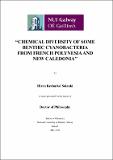Chemical diversity of some benthic cyanobacteria from French Polynesia and New Caledonia

View/
Date
2020-08-04Author
Solanki, Hiren Keshavlal
Metadata
Show full item recordUsage
This item's downloads: 274 (view details)
Abstract
Cyanobacteria are often considered proliferative in relation with the global change affecting oceans worldwide and especially in the coral reefs of the Pacific Ocean. The bloom of the cyanobacteria in the Pacific Ocean are leading to health issues and economic concerns to local communities in French Polynesia and New Caledonia. Only few scientific data have been reported on the chemical investigations of these blooms forming cyanobacterial species from this area. Therefore, this research work focused on the chemical diversity of the bloom forming species of cyanobacteria from French Polynesia and New Caledonia. The main objective of this thesis was to describe the chemical diversity of the three cyanobacterial species: Pseudanabaena sp, Leibleinia gracilis and Lyngbya majuscula, variability in the metabolome of cyanobacterium L. gracilis and assess the biological activities of isolated metabolites. Furthermore, cyanobacteria are known to produce a range of secondary metabolites with structural diversity. The ecological role of these metabolites is still largely unknown but their bioactivity are often of interest for different applications especially in the therapeutical field of research.
An allenic fatty acid, puna’auic acid was isolated from a marine cyanobacterium Pseudanabaena sp. collected from the shallow lagoon of Tahiti and Moorea, French Polynesia. The stereochemistry of puna’auic acid assessed through molecular modelling of NMR and ECD spectra and confirmed through total synthesis.
The second part of my work was dedicated to study the variability in metabolome of cyanobacterium L. gracilis through LC-MS based non-targeted metabolomics and molecular networking analysis built through MS/MS analysis. L. gracilic were found overgrowing the proliferative microalga Turbinaria ornata or dead corals in the lagoon of Tahiti, French Polynesia. Replicates of L. gracili were collected in the same location before and after rainy event, both on dead corals and on T. ornata. Significant variation in the metabolome were observed with impact of change in environmental factors. Erucamide was found as a main chemical marker, which is highly present when cyanobacterium grows on the macroalga. Further chemical investigation of L. gracilic led to identification of oxidized fatty acid derivative 11-oxopalmitelaidic acid as a major metabolite.
The project CYCLADES was supported by the Pacific Fund to give some insights into recent events of dermatitis associated with cyanobacterium L. majuscula blooms in the Drehu island of New Caledonia. Therefore, the last study of my thesis was focused on chemical investigation of L. majuscula. Five new compounds and two known compounds were identified including two cyclic peptides, two modified linear peptides, one alkaloid and two fatty acid derivatives from L. majuscula.
In total, three marine cyanobacterial species were chemically investigated and led to the identification of ten secondary metabolites from which eight are new natural products.

